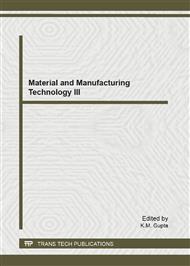[1]
M. Jeljyaskova, I. Sariev, S. Koralska, S. Aneva, M. Pankova and M. Jantscheva: Chem. Tech. (Leipzig) Vol. 34 (1982), p.651.
Google Scholar
[2]
G. Eugenia, S. Petru George, G. Constanta, Z. Florica, P. Sergiu, G. Dumitru, A. Nedelcu, S. Costel, S. Dino, B. Florica Maria and V. Nicolae Serban: Romanian Patent, RO 71056 B 19801205, (1983).
Google Scholar
[3]
J. Chen and K. Huang: Hydrometallurgy Vol. 82 (2006), p.164.
Google Scholar
[4]
K. Shams, M.R. Beiggy and A. Gholamipour Shirazi: Appl. Catal. A-Gen. Vol. 258 (2004), p.227.
Google Scholar
[5]
A.A. de Sá Pinheiro, T.S. de Lima, P.C. Campos and J.C. Afonso: Hydrometallurgy Vol. 74 (2004), p.77.
Google Scholar
[6]
M.A. Barakat and M.H.H. Mahmoud: Hydrometallurgy Vol. 72 (2004), p.179.
Google Scholar
[7]
D. Jafarifar, M.R. Daryanavard and S. Sheibani: Hydrometallurgy Vol. 78 (2005), p.166.
Google Scholar
[8]
M. Baghalha, H. Khosravian Gh. and H.R. Mortaheb: Hydrometallurgy Vol. 95 (2009), p.247.
DOI: 10.1016/j.hydromet.2008.06.003
Google Scholar
[9]
A.B. Chaudhary, Nirupa. Shrinivasan and R.S. Lokhande: J. Chinese Chem. Soc. Vol. 49 (2002), p.207.
Google Scholar
[10]
E.O. Otu and A.D. Westland: Solvent Extr. Ion Exc. Vol. 8 (1990), p.759.
Google Scholar
[11]
T. Kakoi, M. Goto and F. Nakashio: Solvent Extr. Ion Exc. Vol. 12 (1994), p.541.
Google Scholar
[12]
W.A. Rickelton: U.S. Patent 4, 623, 522. (1986).
Google Scholar
[13]
M. Mojski: Talanta Vol. 27 (1980), p.7.
Google Scholar
[14]
F.L. Bernardis, R.A. Grant and D.C. Sherrington: React. Funct. Polym. Vol. 65 (2005), p.205.
Google Scholar
[15]
J.R. Kumar, H. -I. Lee, J. -Y. Lee, J. -S. Kim and J. -S. Sohn: Sep. Purif. Technol. Vol. 63 (2008), p.184.
Google Scholar
[16]
R.L. Mason, R.F. Gunst and J.L. Hess: Statistical Design and Analysis of Experiments with Applications to Engineering and Science (2nd Edition, John Wiley and Sons, USA, 2003).
Google Scholar
[17]
Z.R. Lazic: Design of Experiments in Chemical Engineering (WILEY-VCH Verlag GmbH and Co. KGaA, Germany, 2004).
Google Scholar
[18]
D.C. Montgomery: Design Analysis of Experiments (4th Edition, John Wiley and Sons, USA, 1997).
Google Scholar
[19]
E. Lofstrom-Engdahl, E. Aneheim, C. Ekberg, M. Foreman and G. Skarnemark: Proceedings of the First ACSEPT International Workshop Lisbon, Portugal (2010).
Google Scholar


